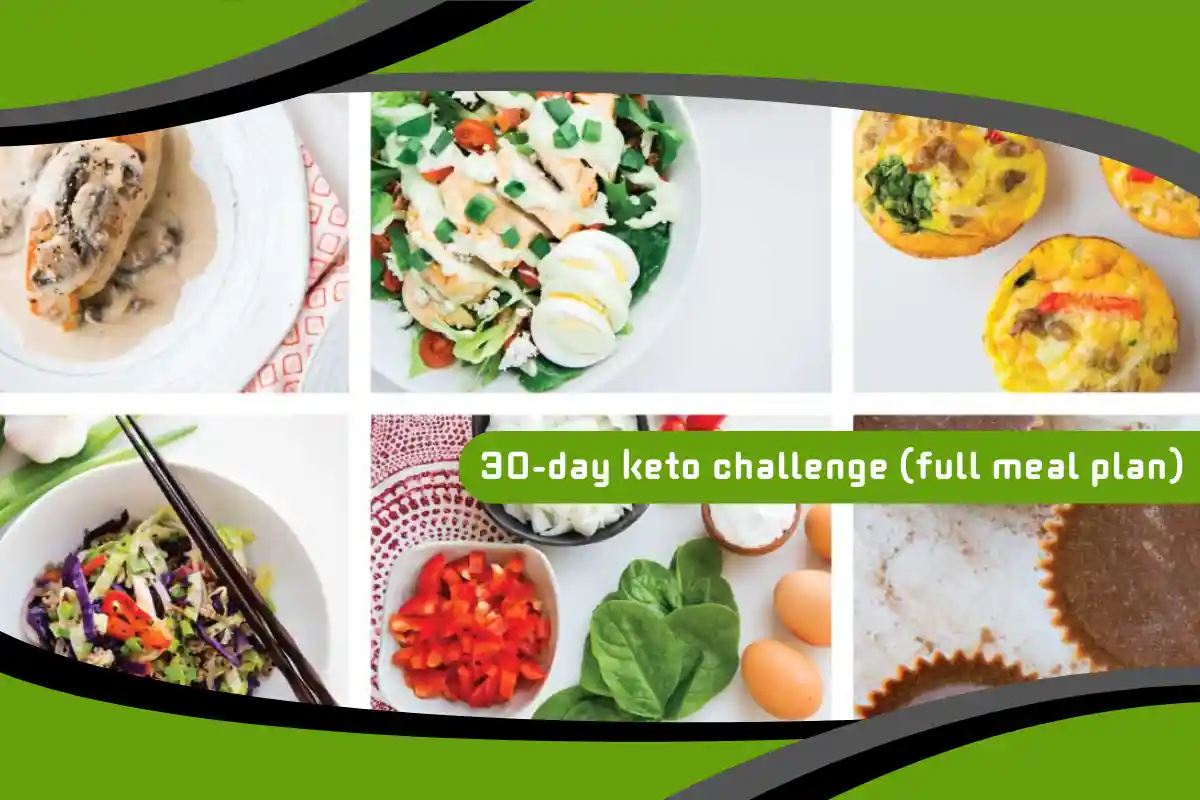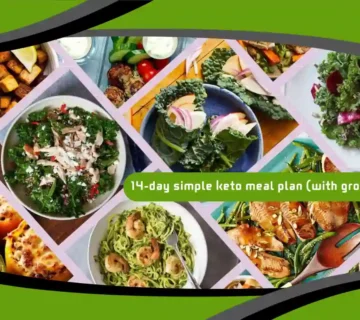The ketogenic diet, often referred to simply as “keto,” has grown immensely in popularity due to its effectiveness in promoting fat loss and enhancing energy levels. The 30-Day Keto Challenge is a structured plan designed to transition your body into a state of ketosis, where it burns fat for fuel instead of carbohydrates. This article will walk you through the full meal plan, nutritional strategies, and key tips for a successful 30-day keto journey. Whether you’re a beginner or looking to reset your metabolism, this guide offers all the essentials.

Understanding Ketosis
Ketosis is a metabolic state where the body relies on ketone bodies derived from fat, rather than glucose from carbohydrates, for energy. Reaching this state usually requires reducing daily carbohydrate intake to around 20–50 grams. The transition period can be challenging, but once the body adapts, many people report increased energy, reduced hunger, and better mental focus. It’s critical to understand ketosis before starting, as it explains the core principle of why keto works so efficiently for fat loss and metabolic health.
Benefits of the Keto Diet
The benefits of the keto diet go beyond just weight loss. It has been linked to improved insulin sensitivity, better control over blood sugar levels, and reduced inflammation. Additionally, many people experience mental clarity, stable energy levels throughout the day, and reduced cravings. Athletes and busy professionals also find keto helpful for sustaining performance without the energy crashes associated with high-carb diets. These benefits make the 30-Day Keto Challenge an ideal reset for both body and mind.
Preparing Your Kitchen
Preparation is key to success. Begin by removing high-carb temptations such as bread, pasta, rice, and sugary snacks. Replace them with keto-friendly foods like eggs, avocados, cheese, nuts, and leafy greens. Stock up on quality proteins such as chicken, salmon, and grass-fed beef. It’s also useful to keep coconut oil, olive oil, and butter on hand for cooking. Organizing your kitchen ensures you’re less likely to fall off track and keeps your meal planning stress-free.
Watch also: High-Protein Keto Meal Plan: A Comprehensive Guide for Fat Loss and Muscle Maintenance
The Importance of Macros
Understanding your macronutrient ratios is essential in the keto diet. Typically, a keto diet consists of 70–75% fat, 20–25% protein, and only 5–10% carbohydrates. These ratios help push your body into ketosis and maintain that state. Using apps or food journals can be helpful to track your daily intake. Once you master the art of balancing macros, the keto lifestyle becomes much easier to manage and optimize for your individual health goals.
Week 1: The Adaptation Phase
The first week is often the most challenging. As your body shifts from using glucose to fat, you may experience the “keto flu” — symptoms like fatigue, headaches, and irritability. Staying hydrated, replenishing electrolytes, and getting plenty of rest can ease this transition. Your meal plan during this phase should focus on simple, whole foods such as eggs with avocado, grilled meats with vegetables, and nourishing bone broth to support digestion and healing.
Electrolyte Management
Sodium, magnesium, and potassium are critical electrolytes that often become depleted on keto, especially in the early weeks. Without proper balance, you may feel sluggish or dizzy. Including foods rich in these minerals—like spinach, nuts, seeds, and salmon—can help. You might also consider supplements, especially for magnesium and potassium. Proper electrolyte balance supports better energy, sleep, and muscle function during your 30-day challenge.
Hydration on a Keto Diet
On keto, your body sheds water weight more quickly due to glycogen depletion. This makes staying hydrated even more important. Aim to drink at least 2.5 to 3 liters of water daily. Infusing your water with cucumber, lemon, or mint can make it more enjoyable. Herbal teas and bone broth are also excellent sources of hydration that add flavor and nutrients to your day.
Intermittent Fasting Integration
Combining intermittent fasting with keto can accelerate fat loss and improve metabolic flexibility. Many keto enthusiasts follow a 16:8 fasting window, eating all meals within an 8-hour timeframe. During fasting hours, the body continues to burn fat efficiently. It also gives your digestive system a break and improves insulin sensitivity. Consider introducing fasting in the second or third week for best results.
Grocery Shopping Tips
Shopping for keto meals can be streamlined with a proper list. Focus on perimeter shopping: meats, dairy, eggs, and fresh produce. Avoid processed foods and anything labeled “low-fat” or “fat-free,” which often contains hidden sugars. Read labels carefully and look out for net carbs rather than total carbs. With time, you’ll become more skilled at identifying keto-friendly products that fit seamlessly into your lifestyle.
Weekly Meal Planning
A successful keto challenge requires consistency, and that starts with meal planning. Each week, map out breakfast, lunch, dinner, and snacks. Use leftovers creatively to save time and reduce food waste. Include variety with recipes like zucchini noodles with creamy chicken, cauliflower mash with grilled steak, and egg muffins with cheese and spinach. Having a clear plan reduces the likelihood of impulsive eating.
Snacking Smart
Snacking on keto isn’t off-limits, but it should be intentional. Opt for snacks that are low in carbs and high in fat or protein, such as cheese cubes, olives, boiled eggs, or a handful of macadamia nuts. Homemade fat bombs made with coconut oil and cocoa are another great option. Snacking should satisfy you, not trigger cravings or overconsumption, so listen to your body’s hunger cues.
Watch also: Back to School Keto Plan for Parents and Kids: A Complete Guide for Healthy, Low-Carb Meals
Dining Out While on Keto
Eating out doesn’t have to derail your progress. Choose grilled meats, green salads, and avoid bread, pasta, and sugary sauces. Ask for dressings and toppings on the side, and don’t be afraid to customize your order. Many restaurants are happy to accommodate keto requests. Staying confident in your choices will help you enjoy social outings without compromising your goals.
Tracking Your Progress
Monitoring your progress helps you stay motivated and make necessary adjustments. Track your weight, measurements, energy levels, and even mental clarity. Consider taking weekly photos or journaling your meals and moods. While weight loss is a common goal, other signs of progress—like better sleep and fewer cravings—are equally important indicators of keto success.
Keto-Friendly Drinks
Water should be your primary beverage, but there are plenty of other keto-friendly drinks. Unsweetened almond milk, black coffee, green tea, and sparkling water are great choices. Avoid sugary drinks and even most fruit juices. If you enjoy cocktails, opt for spirits like vodka or tequila with soda water and lime—just watch the mixers and drink in moderation.
Dealing With Cravings
Cravings can still arise, especially for sugar. Combat them with high-fat snacks, herbal teas, or staying active. Sometimes, cravings are more emotional than physical, so practice mindfulness and distraction techniques. Preparing keto treats in advance can also help you handle those moments without breaking your diet. Over time, cravings usually fade as your body adapts to its new fuel source.
Workout Compatibility
Keto works well with many forms of exercise. While endurance athletes may take longer to adapt, many report increased performance once fully fat-adapted. Resistance training, walking, and yoga all complement the keto lifestyle. You may want to ease into workouts during the first week, then gradually increase intensity as your energy stabilizes.
Meal Prep Strategies
Meal prepping is a time-saving strategy that ensures you always have keto-friendly options available. Dedicate a few hours once a week to prepare proteins, chop vegetables, and cook in batches. Store meals in portion-sized containers for grab-and-go convenience. A little planning goes a long way toward avoiding last-minute decisions that could lead to carb-heavy temptations.
Keto and Mental Clarity
One of the most surprising benefits of keto is improved mental focus. By avoiding blood sugar spikes and crashes, the brain functions more steadily. Many people report greater productivity, enhanced memory, and a sharper ability to concentrate. This makes keto ideal for students, entrepreneurs, and professionals who need to stay on top of their game.
Concluding Your 30-Day Challenge
At the end of the 30 days, reflect on how you feel, what you’ve learned, and whether you want to continue with the keto lifestyle. Some choose to gradually reintroduce carbs, while others embrace keto long-term. The key is understanding how your body responds and what diet makes you feel your best. Celebrate your progress and use it as a foundation for lifelong wellness.
Watch also: 7-Day Keto Meal Plan for Beginners: Easy Low-Carb Recipes to Kickstart Your Weight Loss



No comment